85% of employees scores on project management systems. How do we do our
For the last 10 years, we have used YouTrack, Jira, Asana, Slack, SmartSheet, BaseCamp, Trello and even a whiteboard for project management, as well as constantly testing something new. In our opinion, the main problem of all control systems is that people in the company simply slaughter its use. And it would be great if the information to all departments spread from one system and the whole team actively used it all the time.
And the moment came when, at the weekend, they decided to make their own tool for planning and management. We were confident that the performance of a team of 30 people is really strongly influenced by the task management system.
To begin with, they wanted to implement 2 things:
')
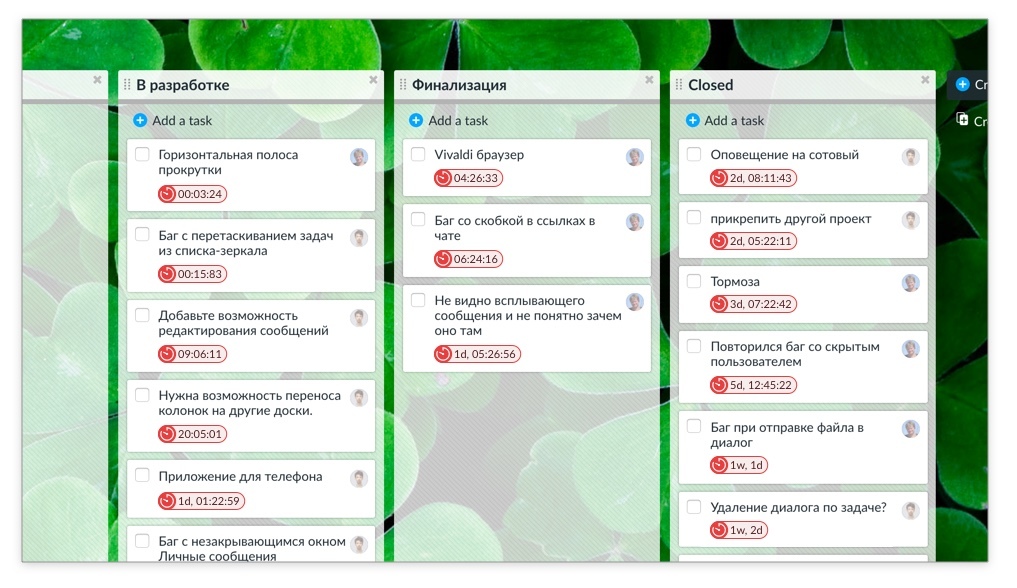
We plunged into this branch of the company, development has been going on for 10 months already, and since the new year we have taken another person for mobile versions. Beta testing is now open , more than 50 teams are actively using our system. Under the cut, we want to share what we have done and tell us which custom approaches to project management have been a failure.
We made simple Agile boards, where each task can be flexibly modified to fit the specific department. At first glance, this is somewhat reminiscent of Trello or YouTrack. The main difference is the stickers that are created and flexibly configured by the user. You can set task cards for any additional meaning and build processes in different departments.
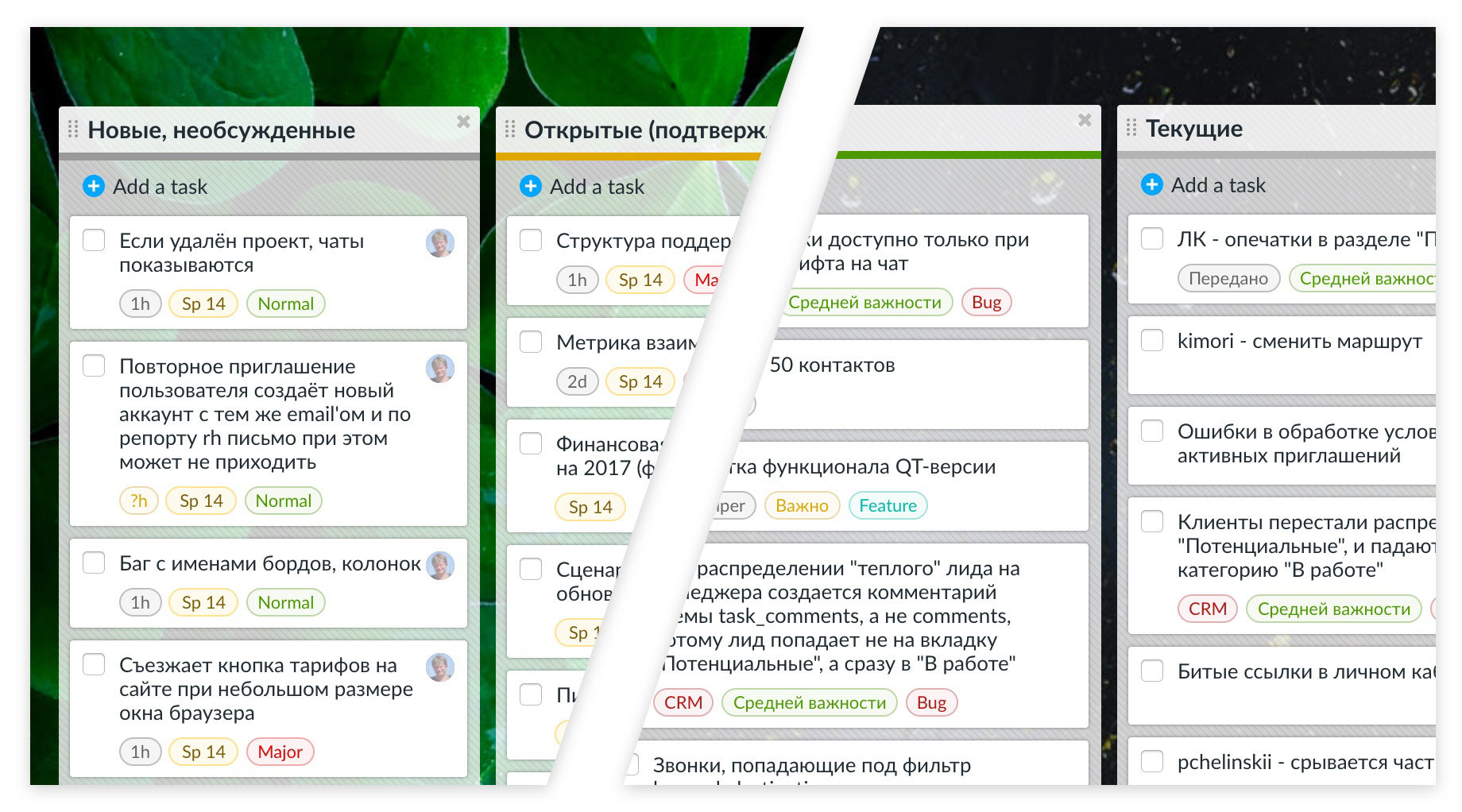
Before the stickers, we had an idea to make something like tags from Slack:
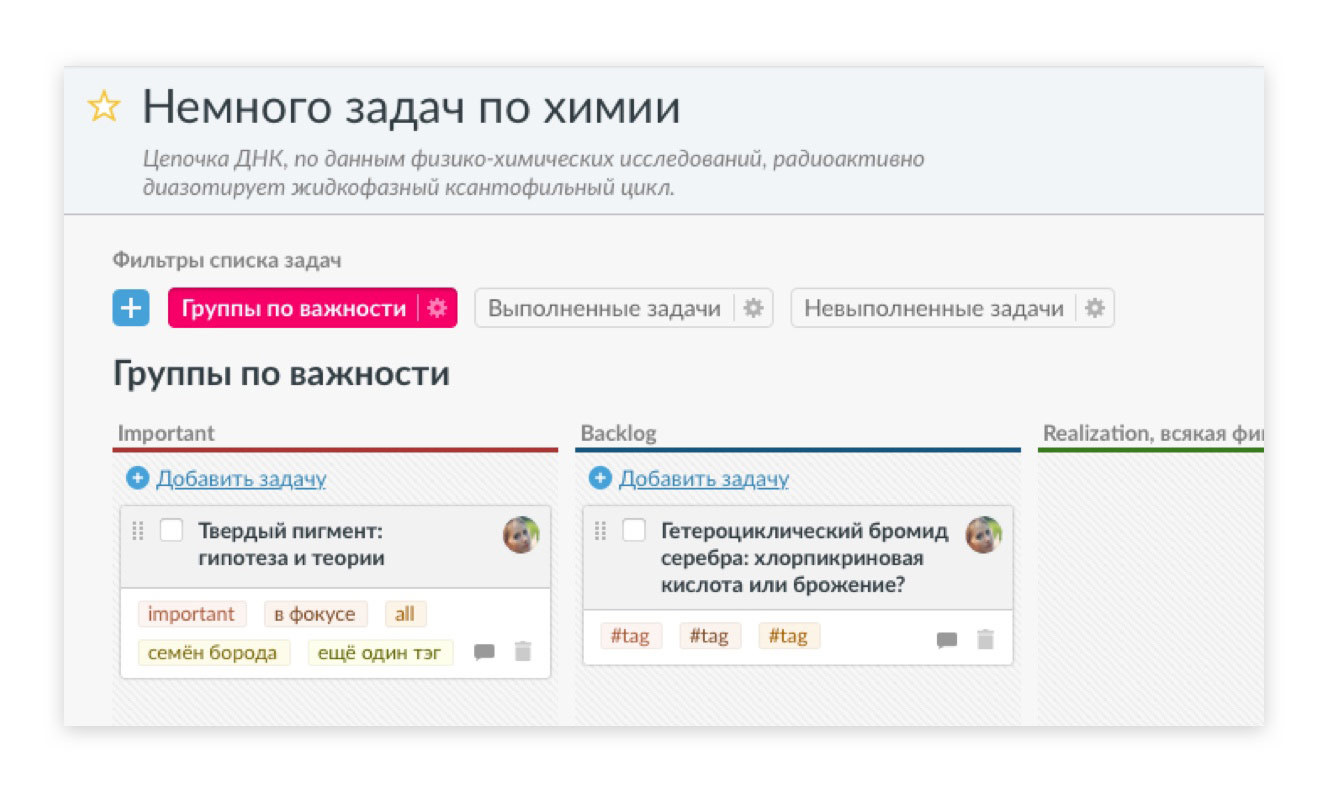
It seemed that the task with tags, which is the channel of communication, is a great idea; you can flexibly set any additional parameters of the card. For example, tag the # Minor unimportant tasks, etc.
The problems started when we opened access to the development board in the sales department (we wanted the information about the product development to come automatically). When they first met, 100% of the sales staff decided that tags were some technical bookmarks that only made sense to programmers. Of course, we told you that by the tag you can find out about the priority of the task or about the sprint (by what time) the release is planned for. But none of the non-techies used it. Visually, the tags are too identical to be easily associated with different meanings. To understand them, you have to constantly think and the system does not extend to the whole team.
In the process of solving this problem, we came to stickers that the user can design himself.
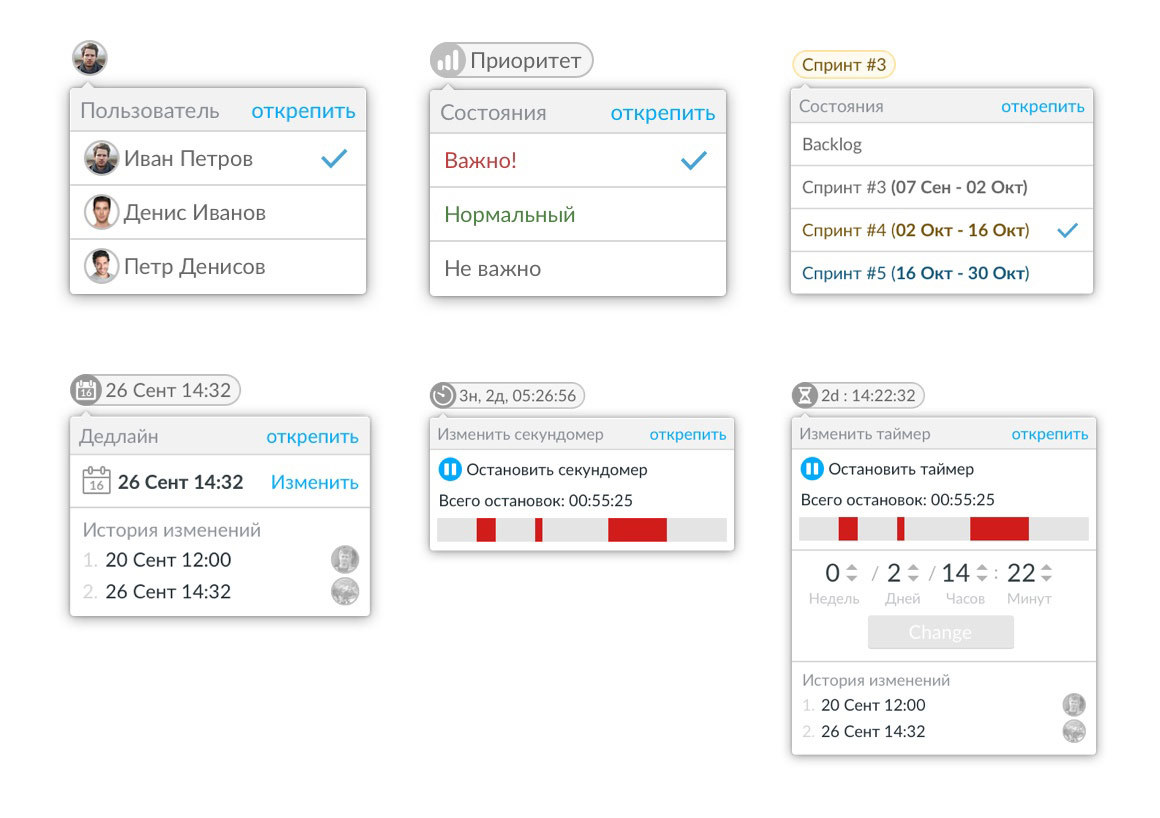
Creating stickers is more difficult than tags, somewhat more difficult to guess all the variations that can be constructed. But absolutely everyone knows what they mean when applied to tasks on the board. Say, someone from the team makes a priority sticker once with three text values Minor / Normal / Major and the whole team works great with it. Visually, the priority sticker is very different from the one responsible for the task (the degree of difference is easy to set up) and as a result, even in accounting, it is clear how the development department works.
In the future, we plan to open API for stickers (in fact, API for arbitrary modification of tasks) and develop templates for specific processes. For example, you can make a sticker that uses a standard card to make a customer card and Agile Board becomes a CRM system. Or a sticker that displays the schedule for the specified events - it will be easy to get a Burn Rate or a schedule for closing tickets in support.
A simple idea, but for some reason not implemented anywhere until the end. In fact, there is a huge difference between the comments in the card at Jira or YouTrack and chat on the task. A full chat pushes people to communicate simply and naturally, you don’t have to build complex phrases like in comments, and solving any small issues in the planning system becomes a common thing. The result is very simple teamwork, which is also structured by task. With the release of the mobile version, viewing tasks will be similar to viewing chats in WhatsApp or Telegram.
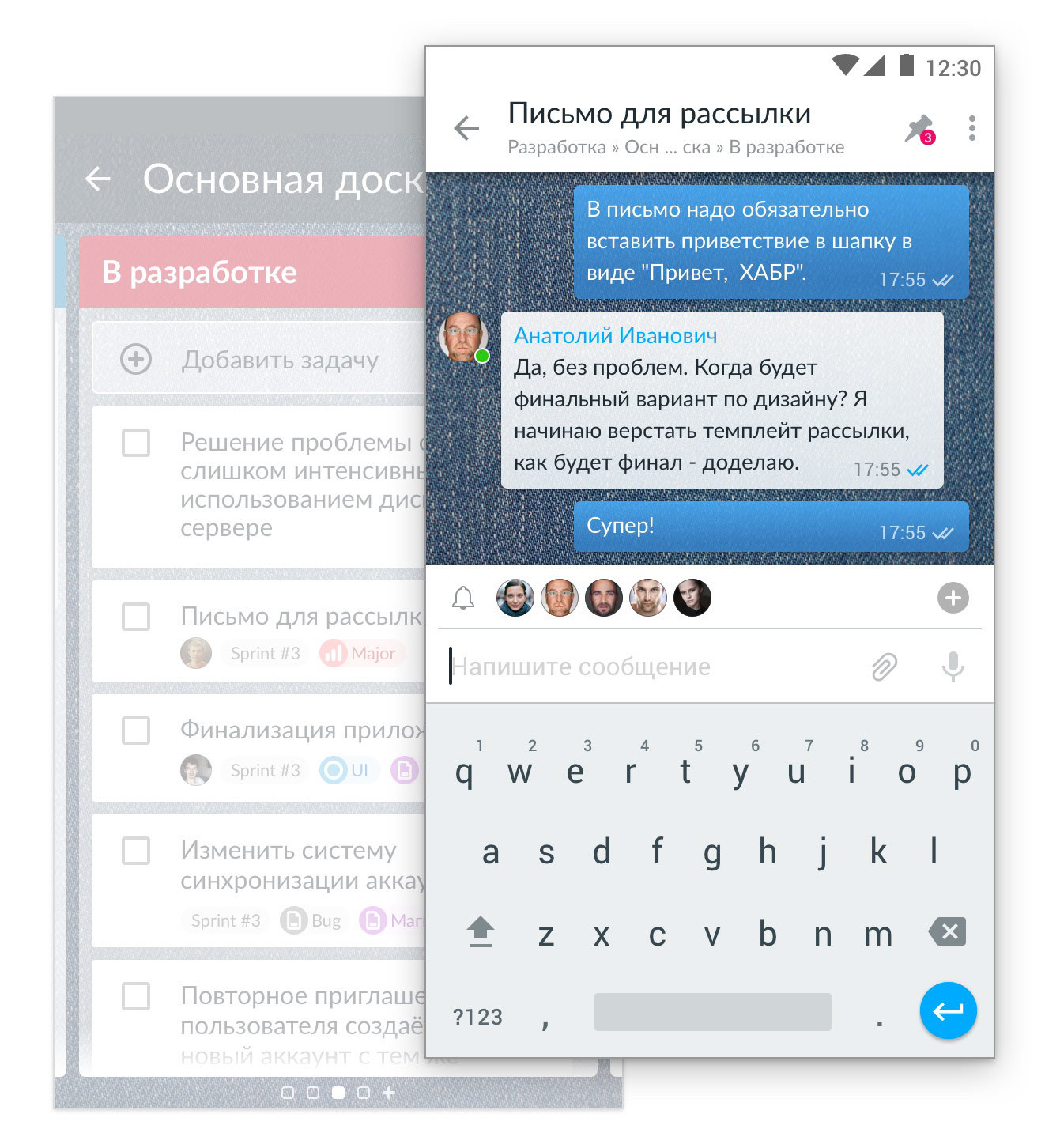
During implementation, we thought about two problems:
To solve the first problem, we introduced the ability to disable all notifications for a specified period of time. And after testing in real conditions, it turned out that when a notification comes to a person with an automatically specified topic of the question (the name of the task), it does not bother him, unlike an incoming message, for example, in Skype. The small question with the title is almost always quite practical. As a result, the silent mode function is practically not used. Chatter happens only in personal messages.
To prevent mess in the cards, we developed the ability to put bookmarks (pins) on the message in the chat header. When you click on them, the chat automatically scrolls to the marked message.

In fact, it turned out that the tasks do not live as long as the channels in Slack and do not have time to turn into a garbage can. An open task sooner or later seeks to be closed, unlike any group chat. According to statistics, the average number of messages in a task is about 10 and only 3% of tasks contain more than 100 messages . The function of “bookmarks” remained in demand, but not for order, but for memorization and simplicity of further search. For example, you throw a PDF file with technical documentation into the chat and put a bookmark on it. Then, simply by clicking on this tab, it is easy to immediately go to the file.
We have been thinking for a long time how to ensure continuous self-informing of the whole team about what is happening inside the company. You can potentially save a lot of time on discussions of what is happening and the work becomes much more interesting when there is an understanding of the big picture. Entirely the problem was not solved, but to some extent it advanced.
We gave the opportunity to make a mirror from any column on the board and place it on the board of another project. Anyone who has access can make a board for observation (spying) on what is happening in other departments.
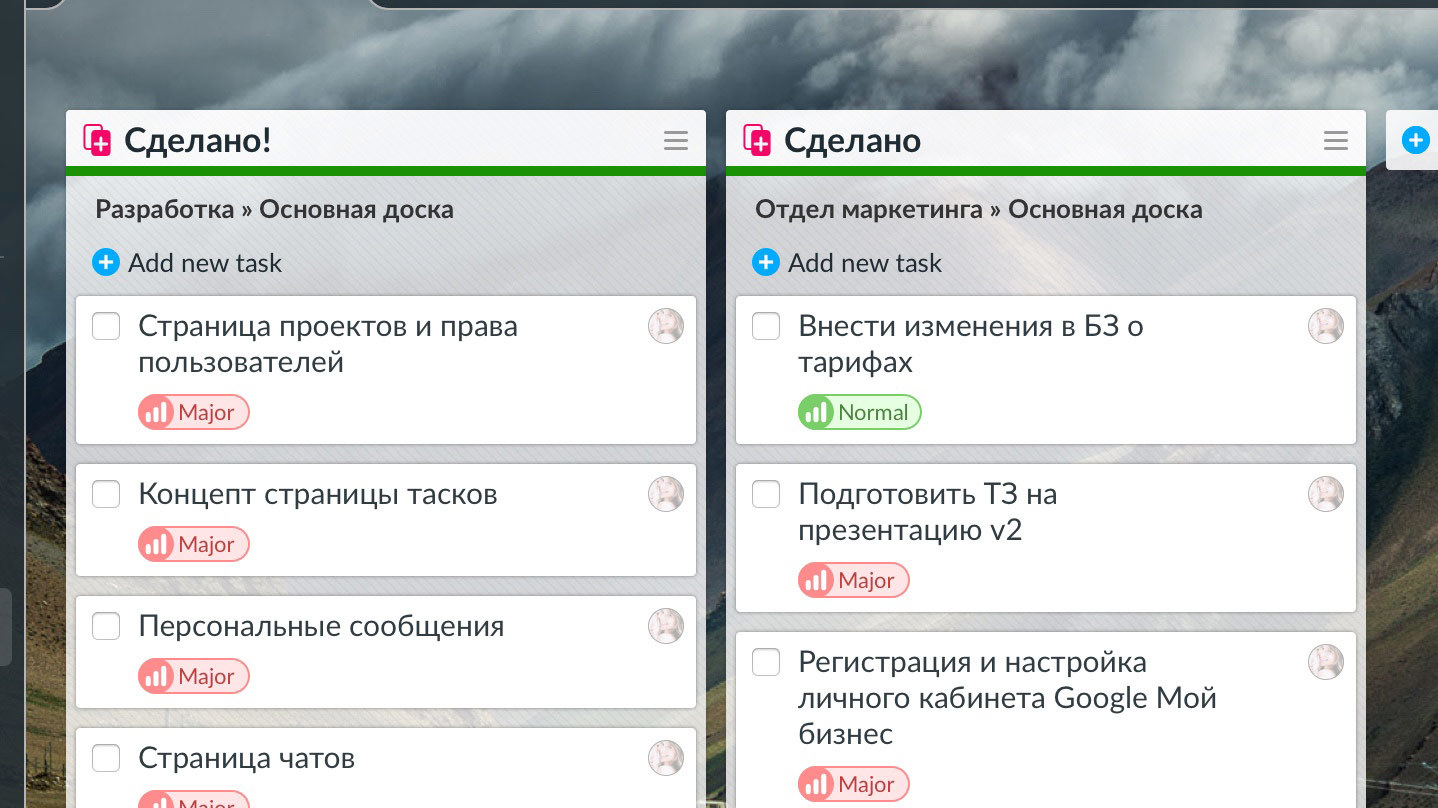
This does not completely solve the problem of informing the company - most are still too lazy to regularly look at changes in the mirror bars. The board, on which all the columns with actual tasks from all departments are displayed, is viewed about once a week and the frequency of views decreases over time.
Actively use the function of those who have built on this process. For example, the mirror of the column with bugs from the support department is placed on the boards of the development department and is regularly viewed by all developers, especially by the tester who missed them.
Involving the whole team in the use of one system
There are still many difficulties with this issue. Now we are focusing on the fact that it was cool for the development departments. The rest of the departments turned out to be quite the simplest of stickers and a beautiful interface, in the development requires a large number of details.
Involving team members in continuous use
It is very important to make sure that the team does not over time scramble to use the project management system. Tightening through chats, tapes with events in the company, design. Now we display a parameter that shows the user involved and see how it changes with the release of updates.
Communications and mobile versions
The second most popular request from our users is a mobile application. During the month we plan its release, the emphasis is on communication.
Map (graph) of information dissemination within the company
If we assume that we will delay more than 50% of all communications in the company and will have information about who is viewing the tasks, then we can build a real picture of how the attention is distributed in the project, what tasks the emphasis is really on, and which are left aside.
Now everything in the open test can be viewed , used , proposed ideas .
Indicated on the site rates - it was the most frequent question from registering. But while we are not in a hurry to collect money, it will not be possible to pay anything :)
And the moment came when, at the weekend, they decided to make their own tool for planning and management. We were confident that the performance of a team of 30 people is really strongly influenced by the task management system.
To begin with, they wanted to implement 2 things:
')
- Stopwatches on each task, because there was a feeling that this would allow to more accurately understand how time is spent in a team;
- Versatility . It was assumed that the development, support and all other departments can work in one system.

We plunged into this branch of the company, development has been going on for 10 months already, and since the new year we have taken another person for mobile versions. Beta testing is now open , more than 50 teams are actively using our system. Under the cut, we want to share what we have done and tell us which custom approaches to project management have been a failure.
1. The concept of universal Agile boards
We made simple Agile boards, where each task can be flexibly modified to fit the specific department. At first glance, this is somewhat reminiscent of Trello or YouTrack. The main difference is the stickers that are created and flexibly configured by the user. You can set task cards for any additional meaning and build processes in different departments.

Before the stickers, we had an idea to make something like tags from Slack:

It seemed that the task with tags, which is the channel of communication, is a great idea; you can flexibly set any additional parameters of the card. For example, tag the # Minor unimportant tasks, etc.
The problems started when we opened access to the development board in the sales department (we wanted the information about the product development to come automatically). When they first met, 100% of the sales staff decided that tags were some technical bookmarks that only made sense to programmers. Of course, we told you that by the tag you can find out about the priority of the task or about the sprint (by what time) the release is planned for. But none of the non-techies used it. Visually, the tags are too identical to be easily associated with different meanings. To understand them, you have to constantly think and the system does not extend to the whole team.
In the process of solving this problem, we came to stickers that the user can design himself.

Creating stickers is more difficult than tags, somewhat more difficult to guess all the variations that can be constructed. But absolutely everyone knows what they mean when applied to tasks on the board. Say, someone from the team makes a priority sticker once with three text values Minor / Normal / Major and the whole team works great with it. Visually, the priority sticker is very different from the one responsible for the task (the degree of difference is easy to set up) and as a result, even in accounting, it is clear how the development department works.
In the future, we plan to open API for stickers (in fact, API for arbitrary modification of tasks) and develop templates for specific processes. For example, you can make a sticker that uses a standard card to make a customer card and Agile Board becomes a CRM system. Or a sticker that displays the schedule for the specified events - it will be easy to get a Burn Rate or a schedule for closing tickets in support.
2. Each task is a chat.
A simple idea, but for some reason not implemented anywhere until the end. In fact, there is a huge difference between the comments in the card at Jira or YouTrack and chat on the task. A full chat pushes people to communicate simply and naturally, you don’t have to build complex phrases like in comments, and solving any small issues in the planning system becomes a common thing. The result is very simple teamwork, which is also structured by task. With the release of the mobile version, viewing tasks will be similar to viewing chats in WhatsApp or Telegram.

During implementation, we thought about two problems:
- Would not it bother when distracted by every detail? The department of development expressed the greatest fears, because the prospect of increasing the number of minor distractions caused aggression.
- Will the task card turn into a garbage dump with a pizza order discussion? It happens all the time with Slack or Telegram here - channels are clogged up and we have to periodically restore order.
To solve the first problem, we introduced the ability to disable all notifications for a specified period of time. And after testing in real conditions, it turned out that when a notification comes to a person with an automatically specified topic of the question (the name of the task), it does not bother him, unlike an incoming message, for example, in Skype. The small question with the title is almost always quite practical. As a result, the silent mode function is practically not used. Chatter happens only in personal messages.
To prevent mess in the cards, we developed the ability to put bookmarks (pins) on the message in the chat header. When you click on them, the chat automatically scrolls to the marked message.

In fact, it turned out that the tasks do not live as long as the channels in Slack and do not have time to turn into a garbage can. An open task sooner or later seeks to be closed, unlike any group chat. According to statistics, the average number of messages in a task is about 10 and only 3% of tasks contain more than 100 messages . The function of “bookmarks” remained in demand, but not for order, but for memorization and simplicity of further search. For example, you throw a PDF file with technical documentation into the chat and put a bookmark on it. Then, simply by clicking on this tab, it is easy to immediately go to the file.
3. Mirroring the posts in the next board
We have been thinking for a long time how to ensure continuous self-informing of the whole team about what is happening inside the company. You can potentially save a lot of time on discussions of what is happening and the work becomes much more interesting when there is an understanding of the big picture. Entirely the problem was not solved, but to some extent it advanced.
We gave the opportunity to make a mirror from any column on the board and place it on the board of another project. Anyone who has access can make a board for observation (spying) on what is happening in other departments.

This does not completely solve the problem of informing the company - most are still too lazy to regularly look at changes in the mirror bars. The board, on which all the columns with actual tasks from all departments are displayed, is viewed about once a week and the frequency of views decreases over time.
Actively use the function of those who have built on this process. For example, the mirror of the column with bugs from the support department is placed on the boards of the development department and is regularly viewed by all developers, especially by the tester who missed them.
Where we think to develop the project:
Involving the whole team in the use of one system
There are still many difficulties with this issue. Now we are focusing on the fact that it was cool for the development departments. The rest of the departments turned out to be quite the simplest of stickers and a beautiful interface, in the development requires a large number of details.
Involving team members in continuous use
It is very important to make sure that the team does not over time scramble to use the project management system. Tightening through chats, tapes with events in the company, design. Now we display a parameter that shows the user involved and see how it changes with the release of updates.
Communications and mobile versions
The second most popular request from our users is a mobile application. During the month we plan its release, the emphasis is on communication.
Map (graph) of information dissemination within the company
If we assume that we will delay more than 50% of all communications in the company and will have information about who is viewing the tasks, then we can build a real picture of how the attention is distributed in the project, what tasks the emphasis is really on, and which are left aside.
Now everything in the open test can be viewed , used , proposed ideas .
Indicated on the site rates - it was the most frequent question from registering. But while we are not in a hurry to collect money, it will not be possible to pay anything :)
Source: https://habr.com/ru/post/321072/
All Articles